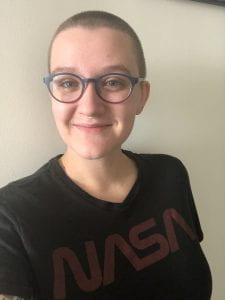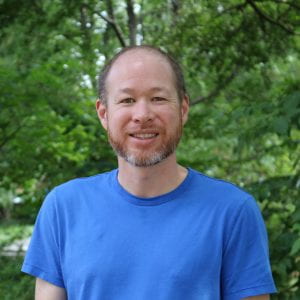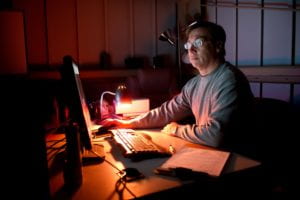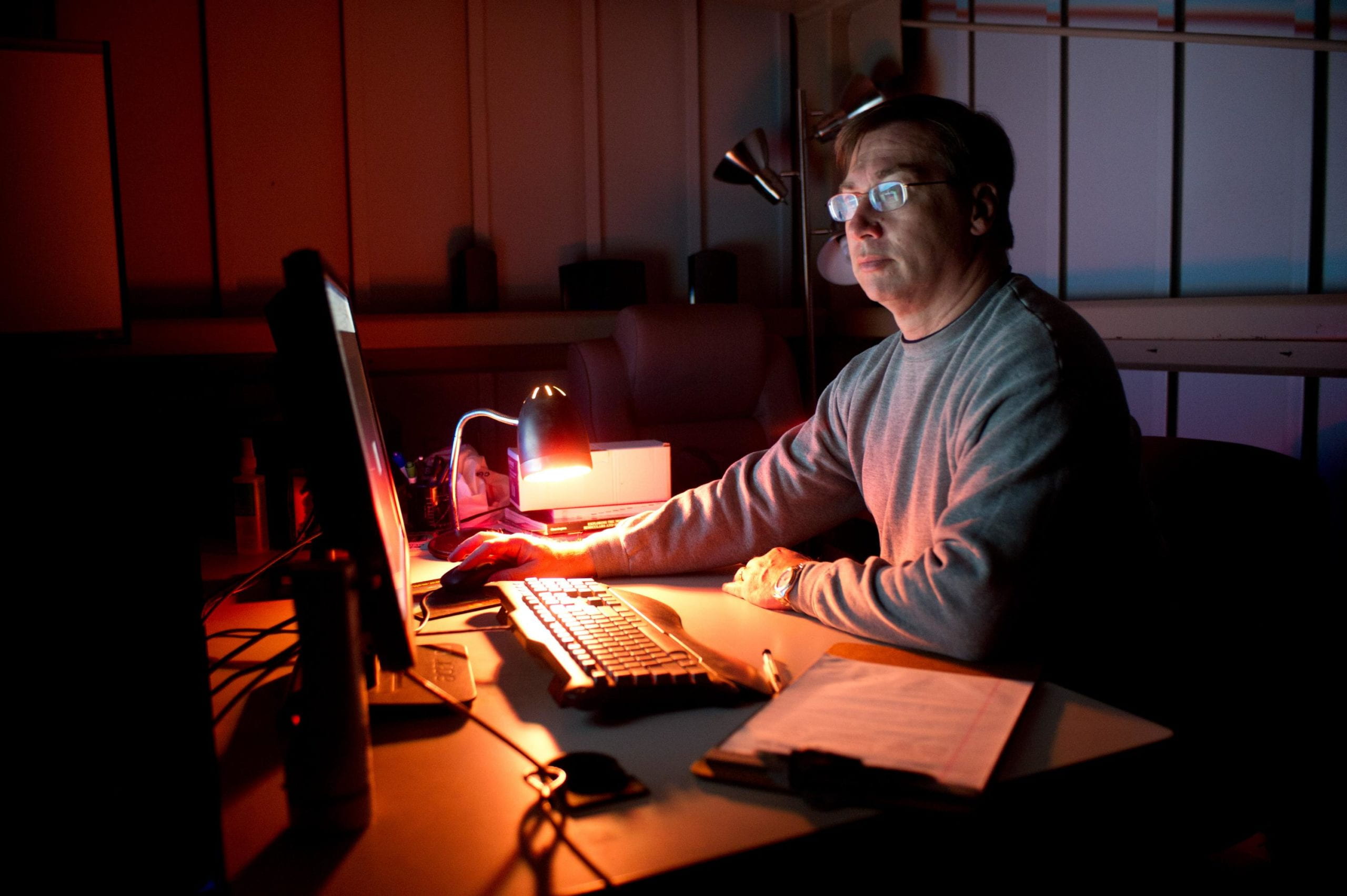For those who were unable to join us for this year’s introductory event for the Center for Relativistic Astrophysics from 09/02/2020, the replay is now uploaded to BlueJeans for you to view. Learn about the science and organization for this new year!
Category: Uncategorized
Danielle Skinner wins NASA grant targeting graduate students
Physics Student’s Search for Precious Metals from Neutron Stars Hits the Funding Motherlode
Neutron stars collide, and a swarm of heavy elements like gold and platinum shoot out into the universe. Danielle Skinner wants to learn more about that process, and thanks to NASA, she won’t have to worry about funding that research for the next three years.

Skinner, a graduate student of associate professor John Wise in the School of Physics, is the winner of a NASA FINESST (Future Investigators in NASA Earth and Space Science and Technology) Award. Only 19 of 158 astrophysics proposals were selected for the fellowship.
“I was surprised to see that I had been selected,” says Skinner, a graduate teaching assistant. “I had to read the email a few times over for it to really sink in.”
“I was ecstatic when I first received news of Danielle’s fellowship,” Wise says. “I am very proud of her. This independent fellowship is very prestigious, and gives Danielle the freedom to explore the mysteries of the early universe.”
Through the FINESST program, NASA’s Science Mission Directorate (SMD) “solicits proposals from accredited U.S. universities and other eligible organizations for graduate student-designed and performed research projects that contribute to SMD’s science, technology and exploration goals,” according to a space agency press release.

“FINESST awards research grants with a research mentor as the principal investigator and the listed graduate student listed as the student participant. Wise, who is also a member of Georgia Tech’s Center for Relativistic Astrophysics, is listed as principal investigator (PI) and Skinner is the future investigator (FI).
“Nucleosynthesis from Neutron Star Mergers in the Early Universe” is the title of Skinner’s proposal. It will take Wise and Skinner back to the early stages of the universe through simulations. An ongoing quest in astrophysics is understanding the evolution of the periodic table, and in particular, figuring out where some of the heaviest elements, like gold and platinum, actually came from.
“We think that in the early universe, merging neutron stars could provide the right environment for these elements to form, and eventually, those heavy elements would end up in stars that we see today,” she says.
Skinner will run a series of simulations where she models neutron star mergers with varying parameters to try to find those with heavy metal abundances.
Online Public Nights: Georgia Tech Observatory Offers Live Looks, Virtual Tours of Venus and the Moon
*For those interested in learning more about astronomy, the next public night will be live-streamed on May 28 at 9:30 PM on the Georgia Tech Observatory YouTube, weather permitting. Mark the date to enjoy a guided tour to the marvels of our universe — from wherever you may find yourself in it!
On May 7, as a full moon came into focus in the night sky, several hundred computer screens lit up for a showing of the evening’s “supermoon” Flower Moon. Through a live stream on YouTube, curious observers tuned into the Georgia Tech Observatory’s first online public night, and were treated to live looks and a guided tour of Venus and Earth’s moon.
Since the Observatory opened in 2007, public nights have traditionally been held on the roof of Howey Physics Building, where four telescopes reach deep into the night sky, and visitors of all ages gather to learn about the wonders of the universe together. But with this year’s campus closures and event cancellations due to COVID-19, spring and summer nights at the Observatory were shaping up to be rather quiet ones — until Observatory Director Jim Sowell teamed up with a colleague to quickly take the outreach program online.

The two-man crew of Sowell and telescope operator John Wallom directed Tech’s inaugural online public night at the Observatory, focusing a telescope connected to a live stream for an in-depth tour of Venus and the moon. Moving from craters to mountains to “lunar maria” — large, dark, basaltic plains on Earth’s moon, formed by ancient volcanic eruptions — Wallom controlled the telescope and handled telecommunications, while Sowell explained the topographies and histories of two of the brightest celestial objects that light up our night sky.
“I have always enjoyed showing views of celestial objects to others,” says Sowell. “It is my opportunity to give a person a peek through a window into the universe.”
During a typical Observatory night, hundreds of curious students and visitors flock to Howey to see the wonders of space. And when Sowell shows visitors planets in person, he says their live reactions confirm his belief in the magic of studying the stars.
“The best aspect about my job is the excitement people share when they see the cratered surface of the moon,” says Sowell. “Many often squeal! It is the celebrated joy of personal discovery and experience which is why astronomers host such events.”
While the adjustment to an online public night prevented Sowell from seeing those reactions in person, he shared that public feedback from far-flung viewers in Florida, Tennessee, and Brazil affirmed the night as a success.
Sowell notes that observatories across the nation carry the responsibility of making astronomy accessible to the public. He says that hosting public nights, that bring the wonders of astronomy to the Georgia Tech community and beyond, has always been a focus for the Observatory. Public nights can also foster curiosity and interest in exploring our universe at an early age.
“I have been in love with astronomy and the night sky since I was very young,” says Sowell. “I got my first telescope when I was seven years old.”
The work of the Georgia Tech Observatory has grown and evolved over time. Several courses, research endeavors, development of the Georgia Tech Astronomy Club, and outreach to the greater Atlanta area are centered as critical facets of the Observatory’s efforts. One example of this work includes a current collaboration between several researchers from the Daniel Guggenheim School of Aerospace Engineering and several GTRI scientists and engineers, who have teamed up to use the Observatory’s telescopes to measure characteristics of earth-orbiting spacecraft.
Sowell shares that one long-term goal is incorporating astronomy into the educational framework for younger students, with the intention of fostering an early interest in astronomy and general scientific discovery.
Richard Udall Selected For The Joyce M. and Glenn A. Burdick Award
Center for Relativistic Astrophysics undergraduate student Richard Udall has been selected for the Joyce M. and Glenn A. Burdick Award from the College of Sciences! Recipients of this award are rising seniors in Physics, demonstrate scholastic achievement, leadership in the School of Physics, and possess characteristics that embody the mission of Georgia Tech.
Congratulations, Richard!
Deborah Ferguson Awarded 2020 Larry S. O’Hara Graduate Student Fellowship
School of Physics Ph.D. student Deborah Ferguson has been awarded the 2020 Larry S. O’Hara Graduate Student Fellowship from the College of Sciences! The Fellowship is awarded to one student selected from nominees submitted from all Schools in the College. The award is a testament to Deborah’s hard work and outstanding research achievements.
Congratulations, Deborah!
CRA student Sudarshan Ghonge won $1500 travel grant at poster competition
Sudarshan Ghonge, a CRA graduate student with Prof. Laura Cadonati won $1500 travel grant at the 2020 Career, Research, and Innovation Development Conference (CRIDC) poster competition.
Congratulations, Sudarshan!
JOBS: 3 POSTDOCTORAL FELLOWSHIPS!
CRA Postdoctoral Fellowship
The Georgia Tech Center for Relativistic Astrophysics (CRA) invites applications for a postdoctoral fellow position at the CRA. This position is expected to be independent and in support of current research at the CRA including astrophysics, cosmology, particle-astrophysics, gravitational wave astronomy, and extra-solar planets. The CRA faculty include David Ballantyne, Tamara Bogdanovic, Laura Cadonati, Pablo Laguna, Gongjie Li, Nepomuk Otte, Deirdre Shoemaker, Ignacio Taboada, and John Wise.
The position is initially for two years, with renewal for a third year subject to performance and availability of funding. The expected start date is September 1, 2020.
Applicants should email to cra-postdocs@nulllists.gatech.edu the following documents in a single PDF file: 1) cover letter, 2) curriculum vitae including full list of publications, and 3) a brief description of research interests (maximum 3 pages). In addition, applicants should arrange to have three letters of reference emailed separately to cra-postdocs@nulllists.gatech.edu. Review of applications will begin on December 16, 2019 and will continue until the position is filled.
The position includes a competitive salary, benefits, research and travel funds, and access to supercomputing facilities. Georgia Tech is an Equal Opportunity / Affirmative Action Employer. We especially encourage applications from women and groups traditionally underrepresented
in astrophysics.
Postdoctoral Position in Numerical Relativity
The Georgia Tech Center for Relativistic Astrophysics (CRA) invites applications for a postdoctoral scholar position in the area of gravitational wave astrophysics including numerical relativity, with an emphasis on binary black hole simulations as they pertain to gravitational
wave astronomy. The successful candidate will work with Prof. Deirdre Shoemaker and collaborate with Prof. Pablo Laguna and the rest of the CRA, for more information see
The appointment will initially be for one year, renewable for up to three years subject to availability of funds and satisfactory progress. The expected starting date is September 1, 2020.
Applicants
should email to deirdre@nullgatech.edu the following documents in a single PDF file: 1) cover letter, 2) curriculum vitae including full list of publications, and 3) a brief description of research interests (maximum 3 pages). In addition, applicants should arrange
to have three letters of reference emailed separately to deirdre@nullgatech.edu. Review of applications will begin December 15, 2019.
Postdoctoral Position in Computational Black Hole Astrophysics
The Center for Relativistic Astrophysics (CRA) at the Georgia Institute of Technology invites applications for a postdoctoral position in Black Hole Astrophysics with an emphasis on modeling of multimessenger signatures of massive black hole binaries. The successful candidate will work with Prof. Tamara Bogdanović and her group on hydrodynamic simulations of coincident electromagnetic and gravitational wave signatures associated with massive black hole binaries headed for coalescence. The candidate will also have an opportunity to collaborate with Prof. Shane Davis (University of Virginia), Dr. Yan-Fei Jiang (Flatiron Institute) and Prof. Pablo Laguna (CRA, Georgia Tech).
Appointment terms: The initial appointment is for one year, renewable for up to two additional years contingent upon satisfactory performance, mutual agreement, and availability of funds. The desired starting date is as soon as possible and no later than September 1, 2020.
Qualifications: A PhD in astronomy, physics, or a related discipline is required by the start of employment. Applicants with research interests in and / or experience in multi-messenger astrophysics, magnetohydrodynamic simulations, modeling of accretion and radiative processes, computational astrophysics and relativity are particularly encouraged to apply.
Application instructions: Applicants should submit a single PDF document including a cover letter, CV, publication list, and research statement (no longer than 3 pages) to Prof. Tamara Bogdanović (tamarab@nullgatech.edu). They should arrange for three letters of reference to be sent to the same email address. Screening of applications will begin on December 15, 2019 and will continue until the position is filled.
Included benefits: All positions include a competitive salary, benefits, research and travel funds, and access to supercomputing facilities. For more information about the Georgia Tech benefits package and resources see http://www.ohr.gatech.edu/benefits. Georgia Tech is an Equal Opportunity / Affirmative Action Employer. Applications from women and groups traditionally underrepresented in astrophysics are strongly encouraged.
The city of Atlanta: CRA is situated at the heart of the Georgia Tech campus in Midtown Atlanta. Atlanta is one of the largest metropolitan areas in the United States and one of the nation’s most cosmopolitan cities. Thanks to its major international airport, it has excellent connections with many cities in the world. Atlanta enjoys a relatively mild (subtropical) climate, is surrounded by rolling hills and has dense tree coverage earning it the nickname of “the city in a forest.” More information can be found here https://postdocs.gatech.edu/new-postdocs/welcome-to-atlanta-0.
Georgia Tech Receives an Award for $400k from the NSF to integrate computing resources into the Open Science Grid
CRA members Laura Cadonati, Nepomuk Otte and Ignacio Taboada and PACE members Mehmet Belgin and Semir Sarajlic have received funding to integrated computing resources into the Open Science Grid. This new funding will enable research with the gravitational wave observatory LIGO, the very-high-energy gamma-ray telescopes VERITAS and CTA and the neutrino observatory IceCube. This award complements MRI-NSF funding obtained in 2018 that will significantly increase the computing capabilities at Georgia Tech’s campus.
Prof. Ignacio Taboada Elected Member-at-Large of APS DAP

Congratulations to CRA faculty Ignacio Taboada for been elected member-at-large of American Physical Society’s Division of Astrophysics (Executive Committee)
https://www.aps.org/units/dap/governance/officers/index.cfm
CRA student awarded A. Joyce Nickelson and John C. Sutherland Prize from the College of Sciences
Congratulations to CRA undergraduate research student Mathilda Avirett-Mackenzie, who was awarded the A. Joyce Nickelson and John C. Sutherland Prize from the College of Sciences.
The award recognizes excellence at the interface of mathematics and physics.


